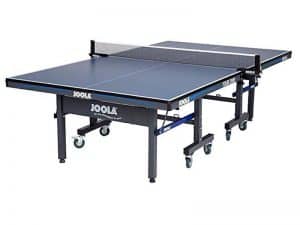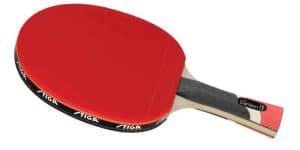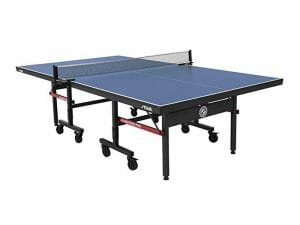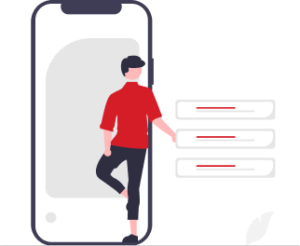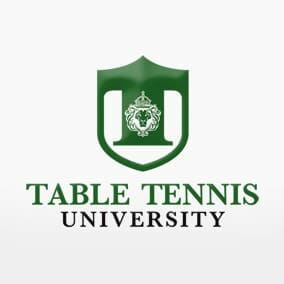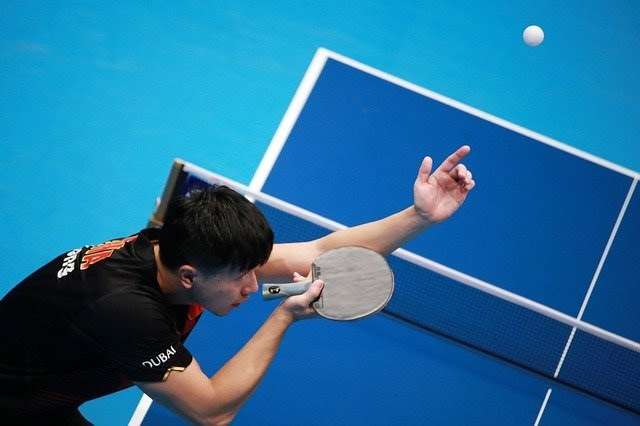How To Do The Ghost Serve in Ping Pong
- Alex Horscroft
- Last updated
The ghost serve in ping pong has a heavy backspin, which causes the ball to travel back toward the net. While this may seem like a table tennis cheat code, I can tell you from first-hand experience it isn’t as strong as you think. Hardly any elite players use this serve at all. Unlike some chop serves, the ghost serve is always short, and the heavy backspin causes the ball to roll back toward the net.
In this post, I describe the strengths and weaknesses of the ping pong ghost serve and provide a breakdown of how to perform it. So read to the end of this article to ensure you don’t miss out on any key info.
Table of Contents
How to Do the Ghost Serve Step-by-Step
Set-up

To do a conventional backspin ghost serve in ping pong, you should stand as if performing an ordinary chop or pendulum serve. If you’re right-handed, your left hip should be next to the left edge of the table, and you should be facing 90 degrees to the right of the direction of play.
Lean forward slightly with your knees bent and your racket out in front of you with a 90-degree bend at the elbow.
Toss

While you only have to throw the ball 16 cm for the serve to be legal, throwing it higher increases spin. This is particularly helpful for the ghost serve as it requires heavy backspin. On the flip side, it also requires a good touch, which becomes more difficult the higher your toss is. Experiment to find the right height for you.
Ghost Serve Motion

Move your racket backward at around a 45-degree angle and keep your elbow fairly close to your body. And then, as the ball descends, move your racket forward and flick your wrist in contact with the bottom of the ball (strong wrist acceleration = strong backspin). Keep your grip loose.
The contact point on your rubber should be near the leading edge. Concerning your ball placement, try not to have the ball bounce too close to the net on the server’s side. Otherwise, the serve will go long.
With correct placement and enough backspin, the ball will travel back toward the net.
How to Return the Ghost Serve
You return the ghost serve much like you would return any other short backspin serve in table tennis. To initiate a backspin rally, push the ball, ideally short, to prevent the opponent from attacking.
However, if you instead want to attack the ball, you usually have to flick it. Because of the heavy backspin, a backhand flick is your best option.
Check out the video of Ma Lin’s table tennis ghost serve below. He is one of the few professionals well-known for having a ghost serve.
Benefits of the Ghost Serve
Short serves are far more difficult to attack than long serves, so the table tennis ghost serve is one of the safest you can do (if you’re good at it). It also has a very high backspin, which makes it even more difficult to attack.
A backhand flick is the only way a player can confidently do so. This means they are very limited, and such a shot is usually easy to return.
Drawbacks of the Ghost Serve
Although some amateur players idolize the ghost serve, this tricky serve is not as useful as it seems. At the professional level, you seldom see ghost serves, which confirms that they are not that useful.
The ghost serve requires the ball to bounce back toward the net, which offers no competitive advantage. Instead, what matters is that the ball bounces twice if you intend to play a short serve.
The ghost serve is also more difficult to perform than most others. This is because it requires a lot of finesse and is very difficult to perform if you want to keep yourself safe. Many players make the serve too slow and high so that the spin can dominate over the speed. As a result, the ball is very easy to attack.
Frequently Asked Questions
Is the Ghost Serve Legal in Table Tennis?
The ping pong backspin ghost serve is legal in table tennis, even if it bounces once on the opponent’s side of the table and bounces back over the net to your side.
Conclusion
The ghost serve in ping pong causes the ball to travel back toward the net, making it challenging to attack. However, it’s difficult to do and provides no real advantage over a standard chop service. Therefore, you’re better off using the latter as it is much easier.
Other Interesting Reads
Freelance writer. Table tennis enthusiast. Lover of all things online. When I’m not working on my loop game I’m probably binge-watching some fantasy show.
-
Alex Horscrofthttps://pingpongruler.com/author/alex-horscroft/
-
Alex Horscrofthttps://pingpongruler.com/author/alex-horscroft/
-
Alex Horscrofthttps://pingpongruler.com/author/alex-horscroft/
-
Alex Horscrofthttps://pingpongruler.com/author/alex-horscroft/
Popular Products
Join our email list for exclusive reviews & the latest Ping Pong News
Sign up to our newsletter and stay up-to-date with the latest news in the ping pong world, and be the first to read our new product reviews. We promise, no spam







